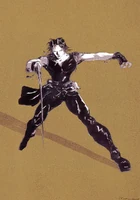Template:Sideicon
Template:Infobox CVG Final Fantasy VIII is the eighth installment in the Final Fantasy series. The game is the second Final Fantasy developed for both PlayStation and PC. It was made available as a PSOne Classic over the PlayStation Network in Japan on September 24, 2009, in North America on December 18, 2009 and in Europe on February 4, 2010.
Thirteen weeks after its release, Final Fantasy VIII earned more than $50 million from sales in the United States, making it the fastest selling Final Fantasy title at the time. Additionally, Final Fantasy VIII was voted the 22nd-best game of all time by readers of the Japanese magazine Famitsu. Final Fantasy VIII went on to become one of the best-selling games in the series; the game had shipped 8.15 million copies worldwide as of March 31, 2003.
Final Fantasy VIII is a departure from many traditional series standards. It is the first Final Fantasy game to consistently use realistically proportioned characters, the first to feature a vocal piece as its theme music, and one of the only titles to deviate from the series' traditional means of increasing a character's power via leveling (although levels are not completely abandoned as they were in Final Fantasy II). In addition, it does not have a Magic Point-based system for spell-casting. Instead, magic is collected, drawn, and created from monsters and objects encountered throughout the game, and is used to power up the characters via the Junction System.
Gameplay
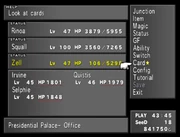
Menu.
The gameplay in Final Fantasy VIII is vastly different from previous titles. The Draw and Junction Systems are the most notable changes. Instead of leveling up in order to learn new spells and abilities via weapons or a job class, the player must Draw the spells from enemies and Draw Points, hotspots scattered throughout the game containing random numbers of a specific spell.
This eliminates the convention of magic/mana points, but encourages players to hoard and conserve spells both for direct use and for junctioning them to different stats associated with Guardian Forces, who also hold the learning of new abilities.
Guardian Forces
A battle in Final Fantasy VIII.
Summoned monsters in Final Fantasy VIII are known as Guardian Forces, often abbreviated to GFs. They require junctioning to characters in order to be used, as well as to utilize their inherent abilities. Unlike previous games, GFs take time to be summoned, and the time taken depends on the character/GF combination. When selected, the ATB gauge begins to run backwards and the character's name and HP are replaced by the GF's name and HP.
Similar to the Aeons used later in Final Fantasy X, the GF have HP and can take damage, shielding party members while being summoned. During the summon charge time, if the GF's HP reaches 0, they get knocked out and the summon is canceled. They also can't be summoned until revived. When the GF's ATB gauge reaches zero, the GF is summoned and attacks in a similar fashion to Final Fantasy VII. If the summoned GF has learned the Boost ability, the player can attempt to boost the GF's attack power by up to 250%, but if the player fails to adequately boost the GF its attack power may actually be reduced rather than enhanced.
Guardian Forces gain Ability Points from battles to learn abilities. Each GF has unique abilities, though rare items allow the player to customize each GF's skillsets. Most abilities at least require junctioning the GF to a character, but some abilities also require junctioning to the character to take effect. Each GF has an ability that, once learned, can be junctioned as a battle command. The first two Guardian Forces are acquired at the beginning of the game. Other Guardian Forces can be acquired through sidequests, or by drawing them from a boss. Only three Guardian Forces are given automatically, the others are optional.
Junctioning
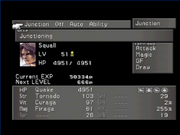
Squall's Junction screen.
The Junction System is the system used for boosting character stats and to give elemental/Status Effect effects to weapons and armor. The player must junction a Guardian Force to enable the use of battle commands other than Attack. Boosting stats requires characters to obtain magic, by drawing spells from enemies and draw points and by refining from items with GF abilities.
The player can junction the spells to stats such as Strength, Vitality, Evasion and Hit-Rate. Which attributes can be customized depends on the junctioned Guardian Force(s). The Guardian Force can learn to unlock more statistics to junction magic to by earning AP in battle, and by the use of GF items.
Experience and Leveling
As with most games of the RPG genre, Experience Points are awarded following defeat of randomly encountered enemies. The system of leveling in Final Fantasy VIII is unique for two reasons: each playable character only requires 1,000 Experience Points to advance to the next level, whereas other games require progressively more points as levels are gained. The statistic increases granted by a level-up are minuscule, as major stat growth is relegated to the Junction System.
The other feature is that enemies and bosses have no set level (although bosses have level caps); they increase in hit points, statistics, and abilities alongside the player party. Higher-level enemies are capable of inflicting and withstanding significantly more damage, and may have additional special attacks. They also possess better magic to draw and items to steal as their level rises. The benefit of this system is no matter where the player is in the storyline, there is a level of difficulty.
Furthermore, due to most locations being visited several times during the storyline and for sidequests, enemies encountered early will grow with the party and can still pose a threat later in the game. There are certain locations that are the exempt to this style of creature leveling, notably the Island Closest to Heaven and the Island Closest to Hell, where all creatures are at level 100 regardless of character level, and the Lunatic Pandora, where all creatures are at level 1 regardless of character level with Squall as party leader (more info here).
Limit Breaks
The Limit Break system in Final Fantasy VIII is a more advanced version of the Desperation Attack system from Final Fantasy VI. Each character has a unique Limit Break based on their preferred fighting style. As a rule of thumb, while a character's HP remains below a certain point, Limit Breaks will become available.
One notable difference between this system and the Desperation Attack feature in Final Fantasy VI is that the player can opt to Attack normally even if a Limit Break is currently available. Another is that the chance of a Limit Break becoming available will increase the lower his/her HP becomes, among other factors. Also, while Desperation Attacks could only be used once per battle, there are no limits to how often Limit Breaks can be performed, so long as the character remains in critical condition.
Several characters' Limit Break sequences are also interactive, requiring the player's skill to reach its full damage potential; if performed correctly, these interactive Limit Breaks can be far more powerful than the non-interactive ones.
Triple Triad
Final Fantasy VIII introduced a minigame that can be played whenever there are NPCs around; a trading card game, known as Triple Triad. Triple Triad varies from a simple easy-to-play game to a complicated one. More rules and variations of other rules come into play depending on what area the player is playing in. And to complicate things further, rules played with in one area are carried to other areas, so the player will want to be careful what rules to pick up while playing.
Cards won from monsters or by playing NPCs can be turned into various items using Quezacotl's Card Mod ability, ranging from screws to items capable of being refined into the most powerful magics in the game. Cards can also be obtained by using Quezacotl's Card command to turn targeted monsters into cards.
Characters
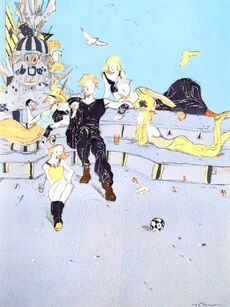
Artwork of the Final Fantasy VIII cast by Yoshitaka Amano.
Final Fantasy VIII has eleven playable characters, six of them used for the majority of the game, three used at certain interludes, and two other temporary characters.
- Squall Leonhart - The taciturn and reluctant hero. A lone wolf, he is known as a fearsome warrior in training, specializing in the rare gunblade. Though aloof and seemingly detached, he grows to appreciate his friends and love Rinoa, evolving into a model leader for his peers. His tagline is "...Whatever".
- Rinoa Heartilly - A beautiful and spirited young woman who abandoned a privileged lifestyle to join a resistance movement. Owns a faithful pet dog, Angelo.
- Quistis Trepe - A top-notch member of SeeD who serves as Squall's instructor. Though beautiful and popular, she is insecure about herself and her capabilities. She overcomes this through her deep caring for Squall and her friends.
- Zell Dincht - A Garden student with unsurpassed martial arts skill who has a passion for hot dogs. In spite of his loud-mouthed attitude, Zell strives to be a model cadet.
- Selphie Tilmitt - A spunky young woman with a carefree spirit. Transferred from Trabia Garden. She tends to overcompensate her sad past with a happy disposition.
- Irvine Kinneas - An expert gunman and consummate ladies' man. Despite his shallow façade, Irvine is determined, caring and sensitive man, and is the only one who knows the hidden connection between all the members of the group.
- Temporarily playable characters
- Laguna Loire - A passionate man whose "pen is truly mightier than the sword". Despite disliking violence, he bravely takes up arms in the face of injustice or when his loved ones are in peril.
- Kiros Seagill - A Galbadian soldier who wields katals in battle. An intellectual and cool person, he is Laguna's best friend and the voice of reason within the group of friends.
- Ward Zabac - A Galbadian soldier who wields a harpoon. Though intimidating at first glance, he is a caring individual and a most loyal friend to Laguna.
- Seifer Almasy - Squall's rival in Garden and a fellow gunblade-wielder. His dream is to become a sorceress's knight as per fabled legends.
- Sorceress Edea - A mysterious sorceress who surfaces as Galbadia's ally.
Story
At the forefront of a rising tide of violence brought on by Galbadia's war declaration is a SeeD cadet named Squall Leonhart. Serious to a fault, Squall has earned himself the reputation of being a lone wolf.
A chance encounter with the free-spirited Rinoa Heartilly, however, turns his universe upside down. Having thrived on discipline, Squall finds Rinoa's carefree attitude fascinating. Yet there is no time to ponder these thoughts, for the job of dealing with the sorceress behind Galbadia's irrational hostility has fallen to SeeD and Squall.Official Introduction
Welcome to SeeD
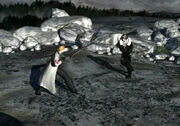
Squall and Seifer duel.
Childhood rivals, Squall Leonhart and Seifer Almasy, duel on a stormy night. Both are cadets at Balamb Garden, a military academy training SeeD, an elite mercenary force contracted to help people all around the world. The duel ends in a tie with both leaving with scars across their faces.
The next morning Squall wakes up at the infirmary on the day of his SeeD field exam. He glimpses a mysterious girl who seems to know him, and leaves with his instructor, Quistis Trepe. Quistis aids Squall in retrieving a new Guardian Force, a creature that enables the use of magic and enhances one's physical capabilities, and then deems him ready for his final exam.
The final test to become a SeeD is at the Siege of Dollet, where Squall—together with his squad members, Zell Dincht and Seifer—must secure the central square of the occupied city of Dollet. They uncover the reason the Galbadian Army has invaded: to reactivate an abandoned radio tower, although they cannot fathom why, seeing as the worldwide radio interference affects all transmissions. Seifer abandons his team and disobeys Garden's orders by leaving their post, and a spunky girl, Selphie Tilmitt, joins the party when delivering a withdrawal order. After Galbadia activates the tower the cadets are chased back to the beach by a spider-like war machine.
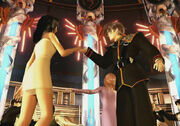
Squall dances with a girl.
Back at the Garden the exam results are announced. Squall, Zell and Selphie are graduated to SeeD by Headmaster Cid Kramer, but Seifer does not make the cut due to having disobeyed direct orders. At the SeeD graduation party a girl asks Squall for a dance. He is initially disinterested, but she drags him to the dance floor. The two dance to the "Waltz for the Moon" but she soon excuses herself.
Quistis takes Squall to the Garden's Training Center for a talk, where she reveals she has been relieved of her position as an instructor. On their way out they run into the mysterious girl Squall saw at the infirmary who calls out to Squall and Quistis who don't recognize her. They defeat the Granaldo that had cornered the girl, and she is led away by men in unfamiliar white uniforms before she has a chance to explain herself.
The next morning Squall, Selphie and Zell are sent out to their first SeeD mission: to aid the resistance faction Forest Owls to reclaim the independence of the nation of Timber. During the train ride the SeeD pass out and dream of a Galbadian soldier called Laguna Loire and his two friends, Kiros Seagill and Ward Zabac, during the time of Galbadia's invasion of Timber.
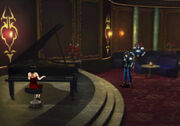
Laguna watches Julia play.
Laguna and his friends battle monsters in the blazing Timber forests, then head for Deling City where Laguna meets a pianist he admires, Julia Heartilly. Laguna confesses his feelings to her but as he is being called away from Julia's hotel room for another mission, the SeeD awaken to find they are arriving in Timber. Disturbed by having shared the same dream, they nevertheless put the matter aside as they meet up with the Forest Owls.
The girl who danced with Squall, Rinoa Heartilly, is a member, and had been at the dance to enlist the SeeD's help. The Forest Owls plan to abduct Vinzer Deling, Galbadia's president, to force him to withdraw his soldiers from Timber, but once they hijack the president's train they confront only his body double.
Opposing the Sorceress
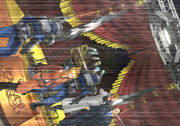
Seifer attacks the president live on air.
After defeating the imposter they learn the real President Deling is going to the Timber TV Station to make a broadcast, for which Galbadia needed the Dollet radio tower. Despite the radio interference the broadcast is successful and the president announces Sorceress Edea as the nation's new ambassador. Seifer takes the president hostage and Quistis, who had been sent to retrieve the rogue Seifer, requests Squall's party's aid. Squall and his friends rush to the studio but the sorceress herself appears and spirits Seifer away, saving the president.
With Garden's reputation at risk following the incident, and return to Balamb Garden made impossible due to the train services having halted, Squall and his friends flee to Galbadia Garden. Rinoa accompanies them as the Forest Owls' base has been destroyed and the members have dispersed to lie low. On the way they again dream of Laguna and his friends, who this time ran into Esthar forces excavating a gargantuan crystal structure at a Centra excavation site.
In Galbadia Garden the SeeD are enlisted to assassinate the sorceress with the help of Galbadia's General Caraway (Rinoa's father) and the master sniper, Irvine Kinneas. Squall suspects they are being used, as G-Garden's Master Martine wants the sorceress out due to her interest in his Garden, but cannot fathom the general's motive. The assassination is planned to take place at Edea's inauguration parade in Deling City. Rinoa, determined to prove herself, comes up with a plan to suppress the sorceress's power with an Odine brand item, but is dismissed by Quistis when she brings it up.
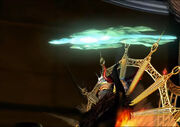
Edea casts Ice Strike.
Rinoa sets out to carry out her plan alone but is struck down by the sorceress. Edea kills President Deling and sets Rinoa up as a sacrifice to be devoured by Iguions, but Squall and Irvine save her. Zell, Selphie and Quistis trap the sorceress inside a gated archway, as Squall, Irvine and Rinoa arrive at their post where a high caliber sniper rifle has been left for them to assassinate Edea. Irvine nearly breaks down, but with a little help from Squall he fires at the sorceress. She blocks the shot with a magical barrier, forcing Squall to attack her head on. Squall is surprised to find Seifer at the sorceress's side, having become her "knight". Edea is disgusted upon discovering Squall is a SeeD, and pierces his shoulder with an ice javelin rendering him unconscious.
Revelations
Squall dreams of Laguna's stay in the town of Winhill where he stayed with a woman called Raine and her adoptive daughter Ellone after having been rescued by the former when he got injured at the Centra excavation site. Ellone was orphaned when Esthar raided the town to kidnap girls to be assessed as Sorceress Adel's successor, Esthar's ruler. Laguna vowed to protect her, Raine and the village. Laguna learned Julia has married General Caraway after her true love never returned from the war.
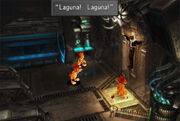
Squall is freed by a Moomba.
Squall awakes in Galbadia's D-District Prison where his friends are being held nearby. Seifer tortures Squall on Edea's orders, demanding to know why SeeD persecute sorceresses, confusing Squall who only knows SeeD as a mercenary force for hire. Squall is knocked unconscious but a worker Moomba frees him, calling him "Laguna", which puzzles Squall further. He joins his friends in a jailbreak but learns the Galbadians have launched missiles against Trabia Garden as part of Edea's plan to annihilate both Trabia and Balamb Gardens. Inferring that Balamb Garden will be next, the group splits: Selphie's team tries to stop the missile launch, while Squall's team goes to warn Balamb Garden. Selphie's party fails to stop the launch and barely survives by hiding inside a wrecked tank when the launch base self-destructs.
Squall arrives to find Balamb Garden in an uproar with students fighting each other, some siding with Headmaster Cid and some with Garden Master NORG. NORG was the one who funded the Garden's foundation and sees it as a mere profit venture. He declared himself the Garden's true ruler and dismissed its true purpose. The conflict of interest sparked the internecine battle among Cid's SeeD and NORG's Garden Faculty. During the commotion Squall learns the Garden can be made mobile and moves the building away from the spot the Galbadian missiles were programmed to target, but as the Garden's steering devices have broken down due to lack of maintenance, Balamb Garden is left adrift in the ocean.
Squall is summoned to the Garden's basement level where he meets Garden Master NORG himself. NORG tries to kill Squall and his companions to appease the sorceress by proving Garden was not behind the assassination attempt, but fails as Squall defeats him. During their conversation NORG let out that Cid and Edea are married, and a confused Squall confronts Cid who admits this is the truth. Cid explains the Garden's true purpose is to enter a fated battle against a sorceress. He is conflicted as the sorceress SeeD is destined to face seems to be his wife, but nevertheless wishes to stay true to the organization's origins.
White SeeD take Ellone away.
The adrift Garden is intercepted by the White SeeD Ship and the crew, calling themselves "Edea's SeeD", want to take Ellone away for her safety. Squall is asked to look for her and he recognizes the name "Ellone" from a Laguna dream. When he locates her he discovers she is the mysterious girl who seems to know him. Squall demands to know what is going on, but Ellone is saddened Squall has forgotten about her. She reveals she is the one sending Squall back in time into a dream world, but won't reveal why. Ellone leaves with the White SeeD leaving a bemused Squall behind.
Balamb Garden crashes into Fishermans Horizon, a pacifist town built around a defunct train station on the Horizon Bridge. Squall is reunited with the missile base team when Galbadia sends its military to occupy Fishermans Horizon and the tank where Selphie and her comrades were hiding in is sent over as well. The Galbadians confront FH's mayor demanding for Ellone's whereabouts as Edea is now searching for her, but the SeeD drive the G-Forces out and the local technicians restore the Garden into full functionality.
Cid places the Garden under Squall's command, a duty he accepts reluctantly. Cid claims this is Squall's destiny but a confused Squall rejects the notion. When the Garden returns to Balamb, Squall finds the town under Galbadian occupation. Under the supervision of Seifer's friends—Fujin and Raijin—Galbadia is searching for Ellone. After liberating the town the SeeD head for Trabia Garden, Selphie's home Garden, which was destroyed by Galbadian missiles.
At the Garden ruins Selphie mourns the wreckage of her home. As Squall, Zell, Selphie, Quistis, Irvine and Rinoa gather to converse over their next action, Irvine reveals that everyone but Rinoa used to live in an orphanage together, cared for by a woman named Edea, but he is the only one who remembers it. As everyone uncovers their buried memories, they realize they had forgotten about their past because of the memory loss brought on by using Guardian Forces, and Irvine was the only one unaffected as he never trained as a SeeD. They decide to investigate the orphanage to find out why Edea has become evil, only to discover Galbadia Garden has arrived there first.
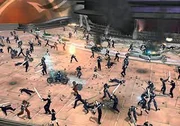
SeeD and SeeD cadets battle Galbadian forces.
They prepare for an assault on the flying Garden, now under Edea and Seifer's control, and the Battle of the Gardens ensues. Squall and his friends infiltrate Galbadia Garden where they face Seifer and Edea, Edea pointing out Squall as the legendary SeeD destined to face her. The SeeD defeat Seifer and Edea, who collapse on the floor. Rinoa begins acting strange and revives Seifer, who departs, before falling unconscious. After Seifer is gone Edea calls out to Squall and his friends in kindness, marveling how they have all grown up. She explains she had been possessed by a sorceress from the distant future named Ultimecia, and that up until now they had been fighting Ultimecia inside Edea's "shell." Ultimecia plans to compress time to gain the sorceress power from every sorceress who has ever lived to become a god-like being, and to enact her plan she sends her mind back in time to possesses other sorceresses. Ultimecia is looking for Ellone, whose mystical powers she needs to cast the time compression spell.
A Sorceress from the Future
Rinoa remains in a comatose state and Squall realizes he is in love with her. He wants to seek Ellone out and have her send him back in time to prevent Rinoa's coma. They find the White SeeD Ship and learn Ellone has gone to the hidden nation of Esthar. Squall takes the Garden to FH and visits Rinoa in the infirmary. He falls asleep and dreams of Laguna taking part in filming a movie on the Vienne Mountains during his quest seeking a way to Esthar to save the young Ellone, who had been kidnapped there on Sorceress Adel's orders. Laguna glimpsed a mysterious floating pillar on the horizon, and as Squall begins to awake he hears Ellone's voice apologizing for having accidentally sent him back in time again. Squall calls out to her but the connection is lost.

Esthar revealed from behind a cloaking device.
Squall resolves to take Rinoa to Esthar himself by crossing the Horizon Bridge. His friends and Edea follow him, Edea explaining she wants to go to Esthar to see a famed scientist Dr. Odine due to her fear that Ultimecia may possess her again. Squall carries an unconscious Rinoa on his back through the Salt Flats where the party discovers Esthar City is camouflaged behind a cloaking device.
As the party arrives in Esthar Squall begins to feel faint and he and his fiends fall asleep to enter another dream world. Laguna had entered Esthar but had been taken captive and was held in forced labor in Lunatic Pandora Laboratory. He broke free and located Ellone within Dr. Odine's lab where Odine had been researching her powers of telepathy and mental time travel.
Upon awakening the party is taken to meet Dr. Odine who inspects Rinoa and Edea is told she is no longer a sorceress. Squall insists on taking Rinoa to see Ellone, and thus at the Lunar Gate the party launches into outer space to Esthar's Lunar Base. The Lunar Base is Esthar's space station for Moon study, but unbeknown to most of the world its true purpose is to oversee Sorceress Adel, Esthar's ruler during the Sorceress War, who is sealed in a spacebound tomb to prevent her from ever passing on her sorceress power.
Back on the ground Zell is left in charge of the remaining party. They are shocked to see a massive black pillar rise from the ocean and fly across Esthar City. The pillar, known as the Lunatic Pandora, was created by Esthar to artificially trigger the Lunar Cry where monsters fall to the planet from the Moon. The weapon was built under Sorceress Adel's rule, but after she was usurped the Lunatic Pandora was deemed too dangerous and sunk to the bottom of the ocean. Seifer engineered its unearthing as part of Ultimecia's plan. Zell's party infiltrates the Lunatic Pandora and discovers it houses the crystal pillar they saw Esthar excavating in a Laguna dream. The pillar originates from the Moon, and thus has an affinity with it. Unable to proceed deeper into the pillar, Zell's party are ejected by a Galbadian robot.
Squall reunites with Ellone.
On the Lunar Base Squall reunites with Ellone who has come to the Lunar Base to meet someone, but won't reveal who. Squall explains he has recovered his childhood memories and now remembers Ellone is his sister from the orphanage, and begs her to send him to Rinoa's past. Ellone explains she has discovered it is impossible to change the past using her ability, but learning from the past can allow one to understand the present.
Ultimecia takes possession of Rinoa's body and forces her way through to the control room. She puts on a space suit and exits out to space where she opens the seal on Adel's Tomb. Ultimecia abandons Rinoa's body in space as the Lunatic Pandora back on the ground triggers the Lunar Cry and monsters pour down to the planet. Adel's Tomb is swept into the current of monsters and falls into the Lunatic Pandora, while Esthar City is decimated.
Lunar Base is being evacuated and as everyone puts on their space suits and enters the escape pods, Ellone sends Squall back in time. He discovers Rinoa was possessed by Ultimecia back at Galbadia Garden when she revived Seifer and ordered him to restore the Lunatic Pandora, but is unable to affect the events. When Squall awakes he begs Ellone to try again, and Ellone sends Squall to Rinoa's consciousness as she floats alone in space. Via Ellone's power, Squall communicates to Rinoa to activate the emergency oxygen supply in her space suit. She does so and Squall exits the escape pod to go after her. He catches up with Rinoa in outer space and they come across the derelict spaceship Ragnarok, which had been floating in orbit near the Lunar Base.
They find the abandoned spaceship still has oxygen and contact the ground base, Squall being surprised to find radio communication is working. Unbeknown to him, it was Adel's Tomb's sealing device that disrupted radio waves back on the planet, and now that the tomb has fallen radio is working. Rinoa has become a sorceress, having unwittingly received Edea's sorceress power when the SeeD defeated her at the Galbadia Garden, and Esthar demands she be handed over to custody as she poses a threat to the world.
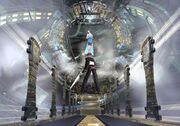
Squall rescues Rinoa.
After Squall and Rinoa land the Ragnarok Rinoa agrees to be sealed away as Adel had been before her and is led away. Squall's friends find him alone in the Ragnarok the Estharians had left behind, and push him into action. He rescues Rinoa and they escape on the Ragnarok back to Edea's orphanage. Rinoa is skeptical of the future, seeing as Squall is the leader of SeeD, an anti-sorceress army, but he assures Rinoa is not his enemy. The two promise to meet at the flower field behind the orphanage should they ever be separated.
Esthar contacts the Ragnarok with a message of wanting to hire Squall's party for one last SeeD mission. The party heads for the presidential palace in Esthar City where they meet the president of Esthar, Laguna. Laguna was the one who usurped Adel all those years ago and succeeded her as Esthar's ruler. His plan had been to return Ellone to Winhill and follow when everything would be over, but Ellone ended up in Edea's orphanage after Raine died and Laguna stayed in Esthar. Ever since he has been ensuring Adel is being kept sealed away in space, and it was him Ellone went to meet on the Lunar Base. Laguna tells the story of how they tricked Adel into being frozen and used Ragnarok model spaceships to transport her tomb to the orbit. Ellone survived the Lunar Base's destruction and landed in the escape pod somewhere south of Esthar, but was seized by Galbadian forces and is now being held captive within the Lunatic Pandora.
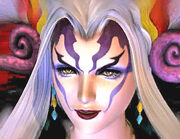
Ultimecia.
The party discusses Ultimecia's plan of time compression with Dr. Odine. Ellone's ability to send one's consciousness into different eras had been studied by Dr. Odine during the time she was held in Esthar as a child, and he had used the knowledge he had gained to create the prototype Junction Machine Ellone. In the future, Ultimecia is using a future version of the Junction Machine to reach back in time to take over the bodies of sorceresses, however, the machine has limitations in regard to how far it can send a consciousness back in time. Thus, it had become Ultimecia's goal to find the real Ellone to send her consciousness even further back in time to simultaneously exist in the past, present and future. With her mind present in all eras of time, Ultimecia would be able to cast the time compression spell and become an omnipotent deity able to control all time, space and existence.
Dr. Odine and Laguna have formulated a plan to stop Ultimecia. SeeD would need to defeat Adel so she would pass her powers to Rinoa, making her the only sorceress left in the present era Ultimecia could exist within. When Ultimecia would possess Rinoa, Ellone would send both of their minds into the past, allowing Ultimecia to cast time compression. Ellone would then severe the link sending everyone back to their respective eras, temporarily halting the spell.
Laguna explains the only way to survive in a universe of compressed time: Squall and his friends would have to keep their bonds strong by remembering each other and thinking of a place they are connected to. Able to survive through time compression with their love and faith in each other, they should be able to make it to Ultimecia's future and defeat her.
Fate's Closing
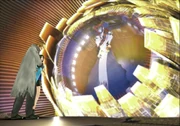
Seifer offers Rinoa to Ultimecia in Adel's body.
The party invades the Lunatic Pandora where they find the Galbadian forces questioning their commitment to Seifer. Fujin and Raijin try to convince Seifer to stop serving Ultimecia and go back to being their friend, and set Ellone free. Seifer says it is too late to turn back now and captures Rinoa and offers her to Ultimecia (now in the body of Adel). Ultimecia junctions Rinoa to Adel's body, but Squall's party fights Ultimecia (as Adel). As Adel's body succumbs she passes on her sorceress power to Rinoa. With no other vessel to exist within, Ultimecia possesses Rinoa, allowing Ellone to send Ultimecia's and Rinoa's minds into the past. With her mind in all eras, Ultimecia casts time compression, though it is temporarily halted when Ellone severs the link sending her mind back to the future.
The partially compressed time allows Squall and his friends to travel to the future and reach Ultimecia Castle. The party finds a dark world ruled by Ultimecia and the corpses of White SeeD around the shoreline of the old orphanage that no longer exists in the future. Squall comments the SeeD has been fighting Ultimecia across generations. The SeeD confront Ultimecia at the summit of her castle and she divulges her plan to create a realm where the SeeD are her slaves.
Ultimecia reaches into Squall's mind and creates Griever, a Guardian Force created from Squall's idea of the most powerful force in existence. After Squall and his friends triumph over Griever, Ultimecia junctions herself to it and after again being bested, transforms into her ultimate form to complete time compression in a battle that shifts through the fabric of time and space. Ultimecia begins absorbing all time, space and existence into herself, merging with it to become an omnipotent deity. The links that bound Squall, Rinoa, Quistis, Zell, Selphie and Irvine prove too much for Ultimecia to overcome and she collapses in an explosion that emanates across space.
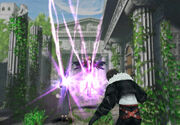
Ultimecia transfers her power to Edea before she dies.
Time starts to revert to its original form and Squall and his friends must find their way back to their own time. Ultimecia and Squall travel back in time to Edea's orphanage, to a time when Squall was only a child and the Garden hadn't yet been built. Squall witnesses Ultimecia passing her powers on to the Edea of the past before fading away. Squall speaks with Edea and mentions Garden and the SeeD. Edea is puzzled as she's never heard of them, and Squall realizes he has traveled too far back and reenters the compressed time.
Squall finds himself in a place gradually slipping into nothingness. He tries to concentrate on Rinoa to make his way back home, but is unable to picture her face. In the present era, Rinoa waits for Squall at the flower field at Edea's orphanage. She transforms a flower petal into a white feather that locates Squall trapped in lost time. He grasps the feather but is too weak to make his way back and falls unconscious, but Rinoa finds him and brings him back to the real world.
Epilogue

Squall and Rinoa kiss.
Seifer spends his days in the company of Fujin and Raijin in Balamb Town. As Balamb Garden passes overhead he looks up and smiles, implying he has moved on. Laguna visits Raine's grave on the hills outside Winhill where he recalls proposing to her, while Ellone, Kiros and Ward watch on at a distance.
The SeeD reunite at Balamb Garden for a celebration party. Edea has abandoned the mannerisms and dress sense of a sorceress and attends the party with Cid. Irvine and Selphie use a video camera to document the festivities, while Squall and Rinoa stargaze on the Balamb Garden balcony and share a kiss.
Music
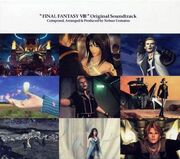
Cover of the Final Fantasy VIII: Original Soundtrack.
The game's soundtrack was Nobuo Uematsu's 23rd work for Square. Released on four Compact Discs by DigiCube in Japan, and by Square EA in North America, a special orchestral arrangement of selected tracks from the game (arranged by Shirō Hamaguchi) was released under the title FITHOS LUSEC WECOS VINOSEC: Final Fantasy VIII, and a collection of piano arrangements (performed by Shinko Ogata) was released under the title Piano Collections: Final Fantasy VIII.
The Final Fantasy VIII theme song, "Eyes on Me", which Uematsu wrote and produced for Hong Kong pop diva Faye Wong, sold a record-breaking 400,000 copies, placing it as the best-selling video game music disc ever released in Japan until the release of "Hikari" by Hikaru Utada for Kingdom Hearts. It won "Song of the Year (Western Music)" at the 14th Annual Japan Gold Disc Awards in 1999, the first time a song from a video game ever won the honor.
Another popular song from the score of Final Fantasy VIII is "Liberi Fatali," a Latin choral piece played during the game's intro. The sorceress theme "FITHOS LUSEC WECOS VINOSEC" was mixed with "Liberi Fatali" and played during the 2004 Summer Olympics in Athens during the women's synchronized swimming event.
The Black Mages, a band that arranged music from Final Fantasy video games into a rock music, arranged five pieces from Final Fantasy VIII. These are "Force Your Way" from The Black Mages published in 2003, "The Man with the Machine Gun" and "Maybe I'm a Lion", from The Skies Above, published in 2004, and "The Extreme" and "Premonition" from Darkness and Starlight.
Development
| Yoshitaka Amano's renditions of Squall and Seifer, though not representative of their in game appearances, still show their visual similarities, most noticeably the scars across both character's faces, each given by the other in battle. | |
Final Fantasy VIII follows Final Fantasy VI and Final Fantasy VII in displaying a world with high technology, diverging from the more traditional medieval feel of the original titles. Final Fantasy VIII diverges further still by focusing the story on the characters instead of the world events. Character designer Tetsuya Nomura wanted the game to have a "school days" feel. Because Yoshinori Kitase already had a story in mind in which the main characters were the same age, the idea worked. Thus, they created the concept of military school-like academies in which the students would train to become mercenaries.
Further on, Nojima planned for the two playable parties featured in the game - Squall's present day group and Laguna's group of twenty years in the past—to contrast with one another. Leading to Laguna's group consisting of characters in their late twenties and have a lot of combat and teamwork experience while Squall's party was young and inexperienced, and Squall himself not initially able to understand the value of friendship.
With Final Fantasy VII, the main protagonist, Cloud Strife, had a reserved nature that led Nojima to include scenarios in which the player can select Cloud's responses to certain situations and dialogue. With Final Fantasy VIII, Nojima wanted to give players actual insight into what the protagonist was thinking and feeling, even while the other characters remained uninformed. This led to Squall's "internal monologues" that appear in transparent text boxes throughout the game.
Kitase also expressed desire to give the game a deliberately foreign, largely European atmosphere. As part of this theme various designs were created using the style of ancient Egyptian and Greek architecture as well as styles from the cities of France and idealized European societies seen in various artworks. Additionally, Kitase explained that the game's logo—Squall and Rinoa embracing—was inspired by the team's efforts to express emotion through body language. The team knew that the Rinoa and Squall scene was a big moment in the game, so they asked Yoshitaka Amano to draw this for the logo. The red to yellow gradient of the logo reflects the sunset in the background of the moment Rinoa is falling toward Squall in the opening cinematic.[1]
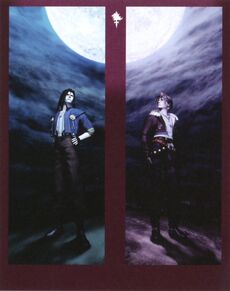
Squall Leonhart (right) and Laguna Loire.
This aim was also referred throughout the game; utilizing the game models to physically display their emotions and actions alongside the text boxes as well as using updated CG full motion videos, which were far more advanced in detail than any Final Fantasy game that had come previously, to convey a kind of 'silent movie' operatic atmosphere that didn't rely on words to convey their meaning.
In terms of character artwork, Final Fantasy VIII reflected Nomura's preferred technique at the time, as opposed to Final Fantasy VII, which featured characters that "weren't really his style." The team had decided to use realistically proportioned characters; the higher level of full motion video technology would have otherwise created an inconsistency between the in-game graphics and the higher definition full motion video graphics. After Final Fantasy VII was finished the development team thought players would feel something is off with the difference in proportion between the character models in battle and on the field, and so in Final Fantasy VIII the character proportions on the field and battle were kept the same.[2]
Nomura ended up altering each of the characters before they reached the final design stage, which required sacrificing his original intentions. For instance, he had originally wanted Seifer to be involved in a love triangle with Rinoa and Squall. As another example Quistis was originally going to be designed with a short skirt, but in the end was given a long skirt worn over pants. Rinoa was originally planned to wear a mini-skirt over shorts, but this led to a conflict as he wished to have at least one female lead wearing a skirt; a compromise was made in this regard with Selphie's design: she was originally intended to be wearing overalls, but Nomura eventually decided that her outfit should be something of a combination of the two, resulting in her overalls-skirt look.Lua error in Module:Cite at line 82: Could not find an entry in Module:Codename/data or Module:Sources matching this input.
A demo version of Final Fantasy VIII was released both for the PlayStation and the PC. One of the games that came with a demo was Brave Fencer Musashi.
Themes
Final Fantasy VIII strives for thematic combination of fantasy and realism. To this end, Final Fantasy VIII was the first Final Fantasy game to have realistically proportioned characters—a departure from the super deformed designs used in the previous titles. The game locations were designed to resemble real world locations, rental cars and trains are used for in-game travel instead of fantasy-like vehicles, and to enhance the feeling of realism, motion capture technology was used to give the characters lifelike movements. Different nations and factions in Final Fantasy VIII have their own flags, their designs based on the country/group's history and culture.
Final Fantasy VIII marks the turn of the series toward a "young adult" genre, similar to the literary genre. It was designed to be bright and fresh in feel, an inversion of atmosphere from the previous two games, Final Fantasy VI and Final Fantasy VII. This decision manifests in the location designs in the use colors, such as the aquamarine and pink design of Balamb Garden or the overall design of Esthar, and even war-ravaged and poor locations, such as Trabia Garden, are displayed as sunny, vibrant and lively, as opposed to the shadowy oppressed slum atmosphere present in Final Fantasy VII.
Final Fantasy VIII is the first mainline title in the series to have "millennium silver" as the color of the menu and dialogue windows, since the color was popular in the late 90's as the world was about to enter a new millennium. This trend was also continued in Final Fantasy IX.
The strive for light and bright feel, however, can conflict with the plot and the characters can appear indifferent and unable to react to tragic events with the seriousness one would expect them to exhibit; for example, after Rinoa has become comatose only Squall appears worried about her, whereas the others remain their cheerful selves, even when Rinoa and her condition is the topic of discussion. Still, one can identify a running theme within the game: dealing with the aftermath of war and tragedy and how people continue on despite of it.
The story focuses on Squall Leonhart, his love interest Rinoa Heartilly, and a small group of Squall's friends and rival. Whereas in Final Fantasy VI and Final Fantasy VII most characters have some playable scenario or side quests of their own, the characters in Squall's party are in more of a supportive role. To strengthen the main character's role the player has less control over his actions in the form of dialogue choices, and as a unique feature in the series, the player can see the main character's thoughts communicated via transparent text boxes.
The story is a coming of age one with a group of orphans originally trained to become mercenaries fight for the sake of the world. School themes are heavy throughout, representing the carefree days of youth, as well as the struggles of growing up. Maturity, tradition and duty are emphasized; as Squall graduates his actions make him a role model and the succeeding leader of the next generation of SeeDs. Though each character starts as something different from what they end up becoming, they share a common background (except for Rinoa, whose background ties to Squall's), and its discovery becomes the turning point for the party's motivations. The bonds formed between the party get a central role to juxtapose with Squall's initial position as someone who relies on no one, and as he remains lost in the void of time compression's collapse Rinoa's love brings him back, transcending and breaking its hold on him.
A major theme is fate and predestination, as well as common Japanese themes of impermanence and inevitable loss (called mono no aware), however the latter themes have been somewhat toned down in the English version; during the final battle Ultimecia asks the party to reflect on their childhoods, but in the Japanese version she explains that childhood feelings fade away as time waits no one, making clinging onto them pointless. The story focuses on moving on from the past by showing the cast's childhoods' ends, and Ellone and Laguna's quests, but ultimately, although all things come to an end, the bonds between one another lead to new beginnings.
The game's villain, Ultimecia, is aware of the prophecy of how she would meet her end at the hands of the "legendary SeeD." To escape her fate she pursues time compression to make her the all-ruling God of the universe, but unknown to her time compression allows the "legendary SeeD" to reach her and destroy her. Garden and SeeD exist to train these "legendary SeeDs" to one day fight Ultimecia as per Edea's encounter with Squall in the game's ending, but Squall himself has no knowledge of his role until the end. In keeping with the theme of fate, the characters are often displaced through time in the roles of Laguna, Kiros and Ward, thus being able to "live" through past history, although never having the power to change what has been. Ellone (whose power allows the party to travel in time) touches this subject when she explains to Squall that although one can't change the course of events they can learn and grow through these experiences, bringing again the theme of the importance of growth, and learning from the past to achieve a brighter future.
Ports
PC version
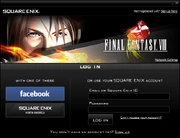
The game launcher of the 2013 re-release version.
Final Fantasy VIII was the second Final Fantasy game to be ported to a Windows platform. It has been released on December 31, 1999 and re-released on December 5, 2013 for Steam.
Similar to Final Fantasy VII, the re-release version comes with the Magic Booster feature that allows the player to boost their characters' magics to 100. Achievements and cloud save data storage are also available. Windowed mode and high resolution displays (up to 1920x1080 @ 60Hz) are now supported. However, the game still uses the original midi songs from the 1999 version, rather than the PlayStation version music, unlike the 2012 re-released Final Fantasy VII that has received a musical update. Chocobo World is playable directly from the launcher after booting up Final Fantasy VIII.
System Requirements
These system requirements are for the re-released version.
| Minimum | Recommended | |
|---|---|---|
| OS | Microsoft Windows XP/Vista/7/8 (32/64-bit) | Microsoft Windows Vista/7/8 (32/64-bit) |
| Processor | 1Core CPU 2GHz or faster | Intel® Core™2 Duo CPU 3GHz or faster |
| Memory | 1 GB RAM | 4 GB RAM |
| Graphics | DirectX 9.0c compatible card | NVIDIA GeForce 9600 GT or faster |
| Hard Drive | 4 GB available space | 4 GB available space |
| Sound Card | Integrated sound chip or more | Integrated sound chip or more |
| Others | DirectX 9.0c Square Enix account |
DirectX 9.0c Square Enix account |
Sales and Reception
At the time of its release Final Fantasy VIII received positive reviews and was commercially successful. After its North American release, Square Electronic Arts announced Final Fantasy VIII had sold near unprecedented amount of units. The game was the number one selling video game in the United States across all videogame software categories and remained on the top spot for three weeks.[3] Final Fantasy VIII grossed a total of more than $50 million in the 13 weeks to follow[4], making it the fastest-selling Final Fantasy title at the time. In Japan it sold more than 3.3 million units within the first month of release[5] and more than 6 million units were sold by the end of 1999. As of March 31, 2003, the game had shipped 8.15 million copies worldwide: 3.7 million in Japan and 4.45 million overseas.[6]
At the time, Final Fantasy VIII was generally viewed as a leap forward from Final Fantasy VII in terms of graphics, but many criticized the junction system as being overly complicated. Many critics praised the game's storyline, but some found it inconsistent in quality and that some plot twists were too sudden with not enough setting up beforehand, leaving players feeling indifferent, although many also praised the game's character development and called Final Fantasy VIII the pinnacle of the RPG genre. In 2002, IGN named Final Fantasy VIII the seventh best title for the PlayStation of all time, placing higher on the list than Final Fantasy VII.
Final Fantasy VIII was voted by Famitsu readers as the 22nd best game of all time in 2006 [7], and was named one of the 20 essential Japanese role-playing games by Gamasutra, stating "There's a lot that Final Fantasy VIII does wrong, but there's even more that it does right".[8]
Production credits
| Executive Producer | Hironobu Sakaguchi |
|---|---|
| Director | Yoshinori Kitase |
| Music | Nobuo Uematsu |
| Main Programmer | Ken Narita |
| Battle System Designer | Hiroyuki Itou |
| Character Design / Battle Visual Director | Tetsuya Nomura |
| Art Director | Yusuke Naora |
| Scenario Writer | Kazushige Nojima |
| Image Illustration | Yoshitaka Amano |
| Movie Director | Motonori Sakakibara |
| Movie Character Director | Hiroshi Kuwabara |
| Character Modeling Director | Tomohiro Kayano |
| Real‑Time Polygon Director | Akira Fujii |
| Battle Effect Director | Shintaro Takai |
| Motion Director | Tatsuya Kando |
| Card Game Director / Battle Camera Director | Takayoshi Nakazato |
| Lead Field Designer | Kazuyuki Ikumori, Kenzo Kanzaki, Yukio Natakani, Tetsuya Takahashi |
| Event Script Programmer | Shun Moriya |
| Battle Programmer | Hiroshi Harata, Kentarow Yasui |
| Event Director | Hiroki Chiba |
| Map Director | Takeshi Endo, Masaru Oka |
| World Map Director | Ikuya Dobashi |
| Sound Programmer | Minoru Akao |
| Sound Editor | Eiji Nakamura |
| General Manager | Yuji Shibata |
| Localization Director | Aiko Ito |
| Coordination Director | Tchie Tokoro |
| Localization Engineer | Richard Mark Honeywood |
| Marketing Managers | Akira Kaneko, Yasuhiro Suzuki |
| Assistant Manager | Tomomi Nishigaki |
| Localization Assistant | Yuichi Yamada |
| Square Soft, Inc. | |
| Localization Management | Masahiro Nakajima |
| Editors | Brian Bell, Richard Amtower IV |
| Associate Producer | Akihito Kozu |
| Square Electronic Arts L.L.C. | |
| Senior Customer Service Manager | Rick Thompson |
| Vice Chairman | Yoshihiro Maruyama |
| President | Jun Iwasaki |
| Special Thanks | Hideo Yotsuya, Lynn Biscoe, Beeline Group Inc., The Kenwood Group, Saatchi & Saatchi, C.H.E.N. PR |
Packaging Artwork
Template:Gallery
Gallery
Template:See Also Template:Gallery
Trivia
- To date, Final Fantasy VIII has the highest number of Star Wars-inspired names, including Biggs and Wedge, Nida, Piet and Martine, who is named Dodonna in the Japanese version.
- Final Fantasy VIII is the first game in the series that allows the player to name summons.
- Final Fantasy VIII is the first game in the series where Ramuh is not present as the Lightning-elemental summon. He is replaced by Quezacotl.
- Final Fantasy VIII is the first game in which all enemies have a death animation before they fade away.
- During Ultimecia's (as Edea) parade in Deling City, the masked dancers are performing the dance moves from Michael Jackson's "Thriller" music video.
- Final Fantasy VIII is parodied in the Dreamcast game Segagaga, where it is called Final Pharmacy VIII.

Final Fantasy VIII in Charlie's Angels.
- In the first Charlie's Angels movie, in the scene when Dylan approaches a house for clothes, there are two kids inside vigorously button mashing and moving while playing Final Fantasy VIII. Infamously for fans, both kids hold controllers despite the fact the game has no two-player mode, and there are no sequences in which such button mashing would be required (except maybe for when using the boost mode for summons).
- The game's demo uses a track called "Raid on Dollet" for the Dollet invasion. The game's final version does not use that track and it was never released on any official soundtrack album. It is unknown why the track was scrapped, although a widespread theory is that it was removed for legal reasons due to heavy similarities with the song "Hummel Gets the Rockets", composed by Hans Zimmer from the movie The Rock.
See Also
- Final Fantasy in Popular Culture
- Final Fantasy VIII Demo
- Final Fantasy VIII Technical Demo for the PS2
- Final Fantasy VIII Allusions
- Final Fantasy VIII Timeline
- Final Fantasy VIII Artworks
- Final Fantasy VIII Wallpapers
External Link
References
- ↑ http://finalfantasynews.com/2015/02/27/yusuke-naoras-smu-lecture-recap-featuring-new-final-fantasy-xv-concept-art
- ↑ Weekly Famitsu Issue no. 1224 Yoshinori Kitase Interview translated by TheLifestream.net
- ↑ Final Fantasy VIII Tops Videogame Charts
- ↑ FF8 Breaks Sales Records
- ↑ Final Fantasy VIII Is Out!
- ↑ http://www.square-enix.com/jp/ir/e/explanatory/download/0404-200402090000-01.pdf#page=27
- ↑ Japan Votes on All Time Top 100
- ↑ A Japanese RPG Primer: The Essential 20
Template:FFVIII Template:25thcompl Template:Series

